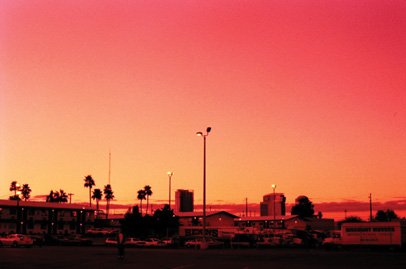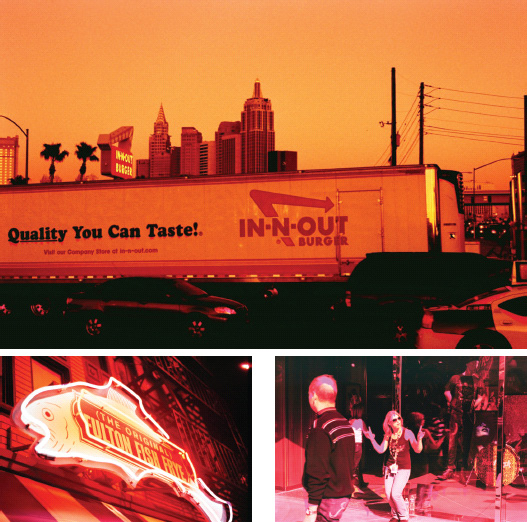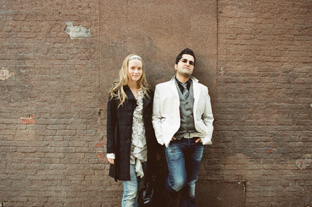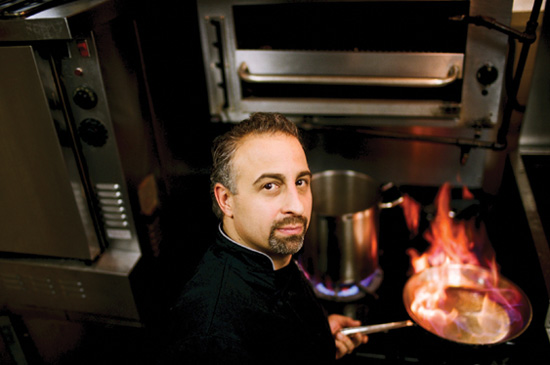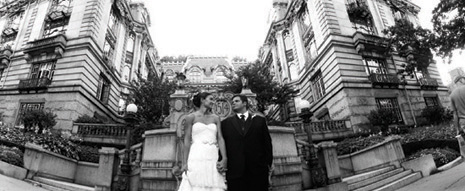4 Current Film Stocks
This image was taken near sunset on Kodak Portra 160NC. It was rated at ISO 80 and developed normally, no push or pull. Look how well the blue sky holds up against the trees that are in both sun and shade. With digital, much of the sky would have been blown out and white. The film held the detail and color.

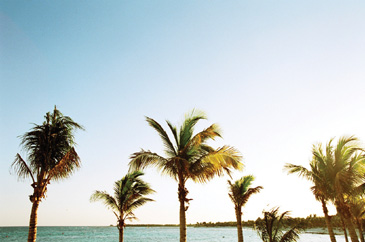
“Every film mentioned in this chapter is a type I have used and love.”
The films available today are very different from the films that were around even just 10 years ago. Not all of the films that were around (even the great ones) made it through the digital age to the new film age. Many films just didn’t sell well enough to keep production going, so sadly, they died. The films that have survived are some of the better—or shall we say more widely used—films, such as Fujifilm Superia, 400H, and 800Z; Kodak’s Portra and Tri-X lines; and the popular Ilford black-and-white films.
I will talk about these films in this chapter, because they are currently available and ready to shoot with. Many expired films are readily available and can be great fun to use, but I want to talk about films that you can get in a pro-camera shop or order online. Every film mentioned in this chapter is a type I have used and love.
With film, you can get very custom looks depending on how you shoot and develop it. Finding the right film for the look you want can take time. I highly recommend ordering a number of different films and trying them out. There is no better way to learn about a film than to test it yourself.
When I test a new film, I throw a roll into my camera and then set the meter (in camera or by using my handheld meter) to the film’s box speed (the ISO at which the film manufacturer has rated the film to be shot), and find a subject—usually my dog, a person, or a flower. I then take several shots: one properly exposed and then two shots in either direction of the meter. (This technique is called bracketing—you take the same image but at different settings.) For example, I might take a photo on ISO 100 film in full daylight at 1/125 at f/16, which is the proper exposure for something in full sunlight on ISO 100 film. Then, by bracketing, I would go to 1/60 and 1/30, overexposing two stops. If I wanted to underexpose the shot, I could do 1/250 and 1/500.
So in essence, to test a film—say, a 400 speed film such as Superia 400—I will take shots of the same subject, bracketing as if the film was rated at 100, 200, 400, 800, and 1600. Then I will have the film developed normally and compare the shots. I do this in different lighting situations and with different subjects. This helps me determine the latitude of the film and how it reacts in different situations, and it gives me knowledge of how it will perform. I generally get prints and lay them all out on a table so I can compare the shots side by side. I find there is no better way to learn about a film than to see it printed and side by side.
Kodak Portra 160
Kodak Portra 160 is my go-to daylight-shooting, outdoor film. Formerly available in natural color and vivid color stock, it has been redesigned with finer grain and the color shifted to that of a more natural, less saturated look. I shoot this film in both 35mm and medium-format sizes. It always looks great, from sunrise to dusk, but it’s not for low light or indoor shoots without flash. This film needs a lot of light. I meter for this film at ISO 100—as you will find out, I like to overexpose my film to really burn in the shadow detail. At 160 this film is good, but I love it at 100 and sometimes at 80 on overcast days. The color is really natural, as expected, and it’s great for portraits and people shots.
“I like to overexpose my film to really burn in the shadow detail.”
Images shot on Kodak Portra 160 film.
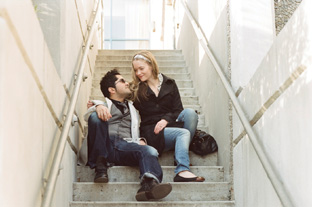
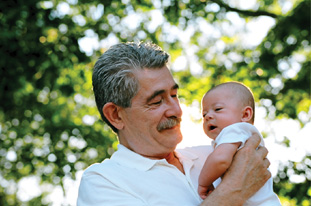
Kodak Portra 400
Kodak Portra 400 is another brand-new film that replaces the older NC and VC versions. This film was based on the Kodak movie-film line and hence has the super-fine T-grain emulsion. This is probably my favorite new film from anyone. It is slightly saturated and makes colors pop. The super-fine grain is ideal for a speed of 400, but what makes this film amazing is its latitude. I can shoot this film; expose it as if it was a 200, 400, 800 or even 1600 film; process the film normally; and get back great photos. Kodak Portra 400 was made for low-light shooting, for shooting with and without flash, and for those times when your lighting is changing so quickly that you need one film that will allow you to keep shooting without worry.
“[Kodak Portra 400] is probably my favorite new film from anyone.”
Portra 400 is my go-to wedding film for color negative for low-light receptions. Daylight balanced, it handles tungsten light and fluorescent lights very well. I like to shoot this film at 250 for portrait work when I want a more saturated look with finely detailed shadow areas. When shooting weddings, I rate it at 800 and then just meter and overexpose when I can. I have even shot this film at 1600 with no flash and just had it processed normally at a one-hour photo processor and gotten back great shots. I prefer to push it one stop if I’m going to rate it at 1600, but you don’t have to. This film was made for low light.
Kodak Portra 400 at 1600 with a one-stop push from a concert I shot in Cambridge, Massachusetts. I just metered and shot the film as it was, at 1600 ISO. I love the color and the contrast I got back.

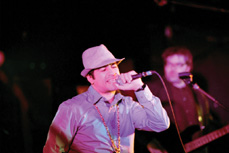
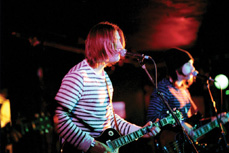
Metering
When I meter for any film or camera, I try to use my Sekonic handheld meter, set the ISO on that, and take a reading. I also use my in-camera meters. Some cameras have better meters than others; it’s up to you to learn how to best use the meter you have.
These images were metered at 250 and developed normally.


NOTE
See Chapter 7, “Pushing Film,” for more information on pushing and pulling.
These images were rated at 1250 with a two-push in development.
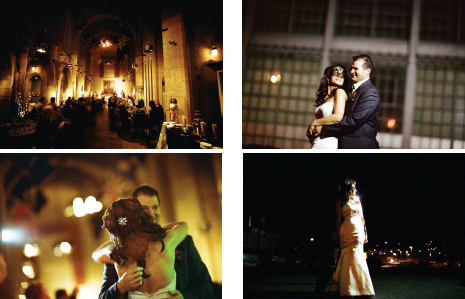
Kodak Ektar 100
If you love color, Kodak Ektar 100 is the film for you. When I want to show super-saturated images with no grain, this is the film I turn to. It reminds me of the old Agfa Ultra 50 I used to shoot in the 1990s. This is a landscape and vista film. I use it for wedding shots, when I want to show off large views and wide shots. However, I don’t like to use it for portraits because it makes some people look a little tanned or orange, depending on their skin tone.
Ektar 100 is available in formats from 35mm to 8×10. Kodak launched this film to reestablish itself as a leader in film formats. Shoot this film in 120, 220, or large format, and no digital camera will come close to producing such a flawless image with such smooth grain. It is the finest-grained film I have ever used.
Images shot on Kodak Ektar 100 film.


Kodak Tri-X 400 and Ilford HP5 Plus 400
Kodak Tri-X 400 and Ilford HP5 Plus 400 are my go-to black-and-white films. They are very low grained, sharp 400 speed films. Being black and white, they are also very pushable (see Chapter 7 for more on pushing), and I generally shoot these films at 1600 or 3200 and rate them a third of a stop or less when I meter. In other words, if I’m going to use the film at 1600, then I meter for 1250; if I’m going to use it at 3200, then I meter for 2500.
I don’t like to overexpose BW film because it’s not like color negative film, which holds the details in the overexposed areas. I find that sometimes it better to slightly underexpose, get less contrast, and then add the contrast in scanning or post-production.
BW film is very unique in that its look can be very personalized by the way you shoot, develop, and scan it. There are a variety of different developing solutions for these films—some that will reduce grain, others designed for speed. You have many choices.
“I don’t like to overexpose BW film because it’s not like color negative film, which holds the details in the overexposed areas.”
NOFEAR
What—you brought the wrong film? Get over it—shoot it at what you need it to be and have your lab push process it. You will be amazed at what film can do.
When shooting people with fair or pale complexions with this film, make sure to overexpose a third or more of a stop so that they don’t end up gray and underexposed. (So, for example, if your meter is telling you f/2.8, I would shoot at f/2.2 or f/2.) Your camera meter will want to make things neutral gray and flat, so neutral gray in BW is gray. Just a heads up.
Both of these films are available in 35mm and 120mm formats.
Pushing Film
Some films are pushable—that is, they can be shot and developed as if they were a high-speed film. This is done in two parts: First, if you’re shooting a roll of, say, 400 film, you set your camera meter or handheld meter at 1600. Then you have the lab push the roll two stops. This means they will keep the film in the developer longer, increasing the contrast and changing the gamma curve of the film. If you are going to push film, make sure to shoot it at the same setting for the entire roll.
Images shot on Tri-X 400 and HP5 Plus 400 film at 1600.
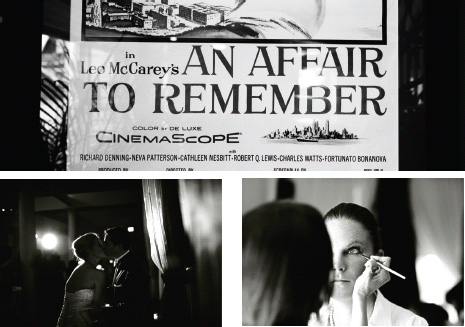
Kodak TMZ 3200
This is a great film. I haven’t shot a ton of it, but every time I’ve used it, I’ve been very pleased with the results. It’s a high-speed true 3200 film. By “true,” I mean that you can shoot the film at the box speed of 3200 and get good shots. However, I always rate it at 2000 or 2500 and meter for the highlights in an image to get better contrast.
If you’re going into a low-light situation, this is a great film to have on hand.
Images shot on Kodak TMZ 3200.

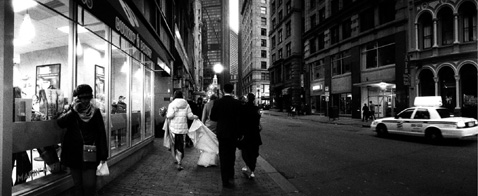
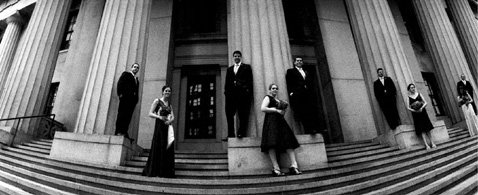
Kodak BW400CN is a great black-and-white film that is processed as typical color negative film. It has the same wide exposure latitudes as the other Kodak color negative films and can be overexposed by a few stops while still retaining detail in the highlights. This is my favorite black-and-white film to shoot for weddings because it is so versatile. It has a fine film grain and nice tonal range.
Images shot on BW400CN.

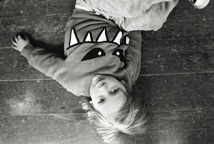
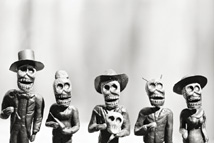
Ilford Delta 3200
“I love, love, love this film.”
Ilford Delta 3200 is my go-to high-speed BW film. I love, love, love this film. It has awesome grain structure and gives you the ability to create beautiful images in both daylight and no-light situations. I use this film in both 120 and 35mm versions. When I load it into my Pentax 645 and shoot, it gives me great contrast and low grain for a 3200-speed film. When I shoot it in 35mm, I get lots of grain and less contrast in the image. You can get two different looks because of the way the grain resolves into an image in different image-capture sizes.
I rate this film at 2000 when I shoot it, and I always meter for the highlights. I like the high-contrast look it gives me. If you want less contrast, just meter it on the highlights at 3200 or push it to 6400 for those super-low-light situations.
Images shot on Ilford Delta 3200, taken on my Pentax 645 at a wedding and in daylight situations.
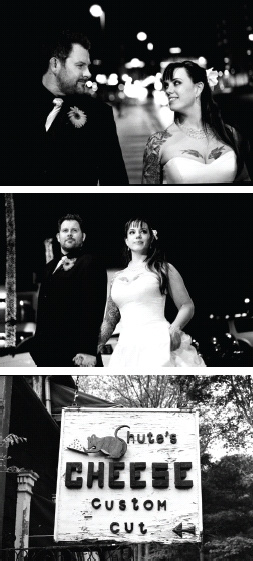
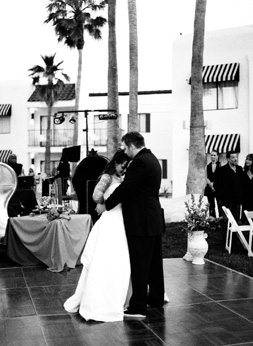
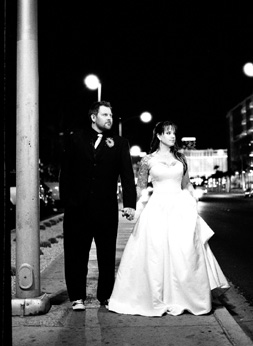
Fuji Superia 800
This film is marketed under many different names—some discontinued and others still around. Fuji has many films in Japan that you can’t always get in the U.S. When I shot tons of this film, it was called Fujicolor Press 800. The only difference between it and the Fuji Superia 800 film was that it was kept refrigerated to help control the film’s quality. As of this writing, you can still get this film in 24- and 36-exposure rolls.
I have always loved this film. It’s not a low-grain film; it’s a grainy film. It has a unique, very “newspaper” look that I fell in love with. I rate this film at 640 when shooting it, and I always overexpose. Superia 800 film needs light. It can also be shot at 1600 with a push in processing to help with the contrast. I have shot this film at weddings, rated it in camera at 1250, and had the lab push it one stop with great results. In low light, the shadow detail won’t be great, so overexpose when you can and use flash as well. When rated at 800 and developed normally, you can get a nice washed-out look, too—even better if the film is expired. It’s one of my favorite films for a truly unique film look.
This film has a big brother called 800Z, a pro version of it. I have not shot 800Z in a long time, but I expect it is very much like the Fujicolor Press, and I would shoot it at 640 and tend to overexpose.
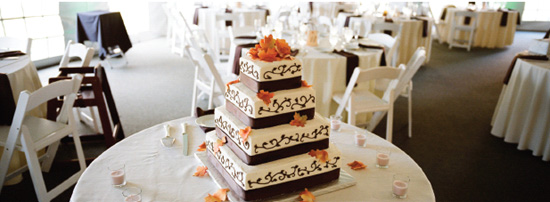
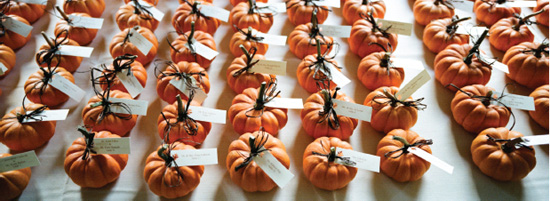
“[Superia 800] is one of my favorite films for a truly unique film look.”
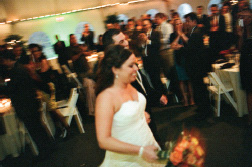
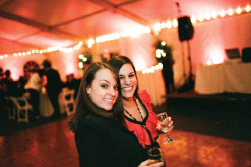
Images shot on Fuji Superia 800 with and without flash.
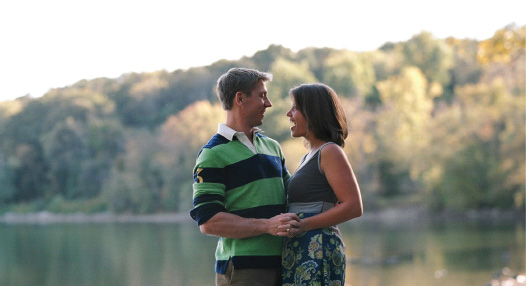
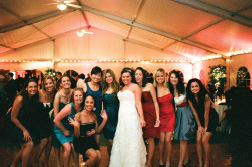
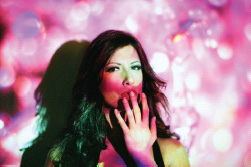
Fuji Superia 400
Superia 400 is a consumer film that Fuji makes and sells around the world. I love this film, too. It’s a high-contrast and saturated film, but with great latitude. I have shot this film at 200, 400, and 1600 and gotten pleasing results. I don’t really like to shoot it at 200, though, because it’s already a high-contrast film; I find it works best at 400 and 800.
If I shoot it at 800 or 1600, I like to overexpose as much as I can with respect to what I’m shooting. I shoot this both for personal work and at weddings, for shots of people dancing or just general-coverage shots. I wouldn’t use it for portraits unless I was going for a high-contrast look.
Images shot on Fuji Superia 400. I took these in Washington, D.C. at the National Harbor while walking around and experimenting with the film’s look.
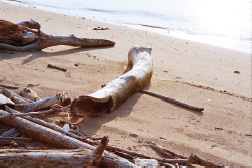
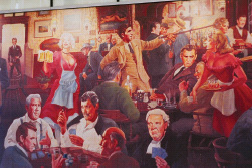
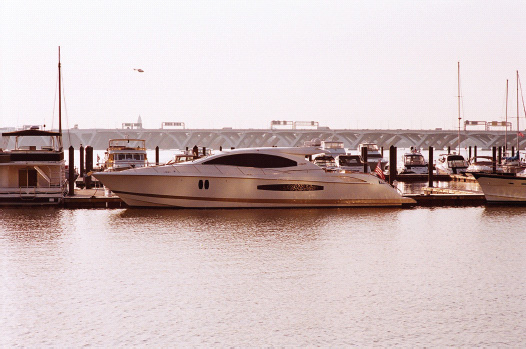
Fuji NPH 400 is a very popular film with wedding shooters because when you overexpose it, it makes for a wonderful creamy skin tone and brilliant green tones. It is a great versatile film for portraits, food shots, and scenery. I rate this film at 100 or 200 ISO. As with the entire Fuji line, the green tones are so beautiful that it’s nice for landscapes, too. It works well in open shade and on cloudy days. When you overexpose the film, the contrast levels are bumped up.
Images shot on Fuji NPH 400.

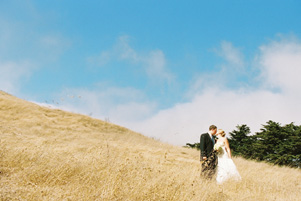
Fuji Sensia and Cross-Processing
Fuji Sensia is pretty readily available; I see it everywhere, and I have tons of it. A consumer slide film, it has great color and low grain—but that’s not why I like it. I like to shoot this film and cross-process it because of the red color shift it creates. When cross-processed—that is, developed in C-41 chemistry as opposed to E6 chemistry—this film gets awesome, with a magenta cast and crazy red glows. It’s a really cool look that I love to play with and use for street shooting. You never know what to expect, but you can always expect something spectacular.
NOFEAR
Experiment! Don’t be afraid to cross-process your film for cool effects.
Different films—even films in the same family, such as Sensia—will color shift differently due to their different chemical compositions. Sensia 100 shifts to the red and magenta spectrum, while Sensia 200 shifts to the green and yellow spectrum. Other films, such as Kodak 100G, just get very contrasty and sometimes shift to cyan. Every slide film will process a different way, so find the one you like and exploit its look for your own pleasure. Just test it before you shoot something important with it.
Cross-processed images from a day of shooting in Las Vegas. I used my F3 and Sensia 100—check out the cool color shift. I love it!
